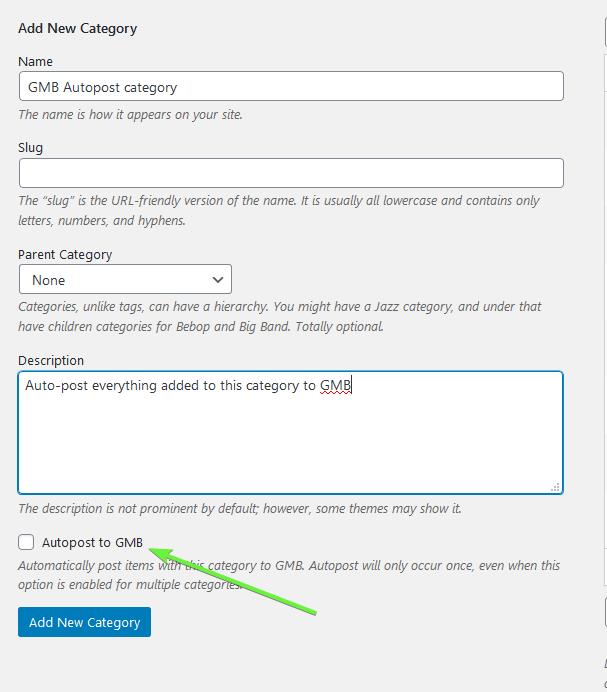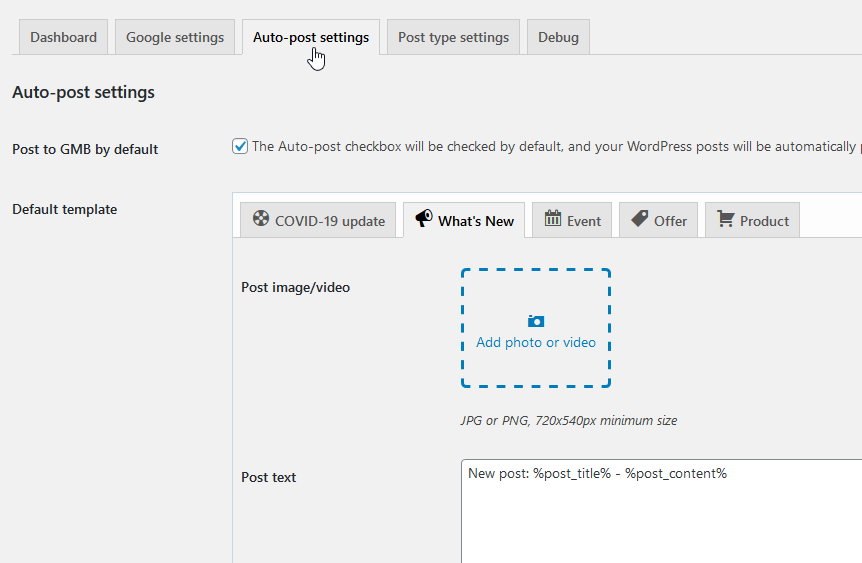Using the auto-post feature
You can use the auto-post feature to automatically publish your latest WordPress posts to Google My Business. To use it, simply tick the Auto-post to GMB checkbox before publishing your WordPress post. As a result the plugin will automatically create a new post on Google My Business when you hit Publish.
Since Google My Business posts do not support rich text formatting, the plugin will automatically remove any HTML code, shortcodes and any other markup from your GMB post.
 While the Post to Google My Business plugin already makes beautiful GMB posts out of the box, you can tweak it to suit your needs! Lets dive in!
While the Post to Google My Business plugin already makes beautiful GMB posts out of the box, you can tweak it to suit your needs! Lets dive in!
Turning auto-post on by default
The auto-post checkbox is unchecked by default. This prevents accidentally publishing items to GMB that were not supposed to be published. However, if you want the checkbox to be checked by default when you create a new post, you can enable this in the settings. In order to do this, go to Post to GMB > Settings > Auto-post settings and enable Post to GMB by default.
 To prevent double-posting, the auto-post checkbox will only be automatically checked when the WordPress post is published initially. On updates it will be disabled by default.
To prevent double-posting, the auto-post checkbox will only be automatically checked when the WordPress post is published initially. On updates it will be disabled by default.
Note: When this setting is enabled, posts that are created on your website outside of the editor will also be auto-published to GMB. This can be extremely helpful if you're using a service such as Zapier, IFTT or Integromat to add content to your WordPress site. But it is also something you should be aware of, as it can lead to "unexpected" posts on your GMB listing.
Auto-post based on categories or tags
Using the Pro package or higher, you can enable auto-post for specific categories or tags. When you assign a WordPress post to a category or tag where this option is enabled, it will be auto-published to GMB. This is a very handy feature to fine-tune what you're publishing.

Customizing the auto-post template
You can customize the default auto-post template in the plugin settings. In order to customize it, go to Post to GMB > Settings > Auto-post settings in your WordPress Dashboard.

Changing the default post image
By default, the Featured Image will be used as your GMB post image. However, you can also have the plugin try to fetch an image from the post content. You can do this by enabling Fetch image from post content under the Advanced post settings.

Optionally, you can simply upload a static image to your post that will be used for every post.
To clarify, the plugin will process the images in the following order: custom image > image from content > featured image. So if you haven't uploaded a custom image, it will try to find one in the post content. If it doesn't find any, it will use the Featured image (if any). If it doesn't have a Featured image either, your resulting GMB post will have no image.
What variables can I use?
You can use a multitude of variables in your post template which will be automatically replaced by their corresponding value (if any).
Post Variables
These variables contain details about the WordPress post you are currently editing.
Common variables
- %post_title% - The post title
- %post_content% - The Post content
- %post_excerpt% - The post excerpt
- %post_date% - The post date in local time
- %post_date_gmt% - The post date in GMT time
Others
- %ID% - The post ID
- %post_author% - The post author ID
- %post_password% - The post password
- %post_status%
- %comment_status%
- %ping_status%
- %post_name%
- %to_ping%
- %pinged%
- %post_modified%
- %post_modified_gmt%
- %post_content_filtered%
- %post_parent%
- %guid%
- %menu_order%
- %post_type%
- %post_mime_type%
- %comment_count%
- %filter%
Author variables
These variables contain the details of the author of the current WordPress post
Common variables
- %author_first_name%
- %author_last_name%
- %author_nickname% - The value of the Display name field
- %author_display_name% - The value of the Display name dropdown box
- %author_user_email%
- %author_user_nicename% - Username
- %author_user_url% - User website
Others
- %author_description%
- %author_jabber%
- %author_yim%
- %author_aim%
Site variables
These variables contain details about your WordPress website.
Common
- %site_name%
- %site_description%
- %site_url%
Others
- %site_pingback_url%
- %site_atom_url%
- %site_rdf_url%
- %site_rss_url%
- %site_rss2_url%
- %site_comments_atom_url%
- %site_comments_rss2_url%
Location variables
These variables contain details about the Google Business Profile location that you are publishing your post to.
- %location_title% - The name of the location
- %location_phoneNumbers_primaryPhone% - The primary phone number of the location
- %location_storefrontAddress_postalCode% - The postal code of the location
- %location_storefrontAddress_locality% - City
- %location_storefrontAddress_addressLines_0% - First line of the address (increment the zero if you have multiple)
- %location_websiteUri% - Website URL
Using the auto-post feature in combination with these variables allows you to create unique Google My Business posts without having to write a single word.
The premium version of Post to Google My Business allows the usage of these variables in any text field. Additionally you can use the Spintax feature to make your posts even more unique.
